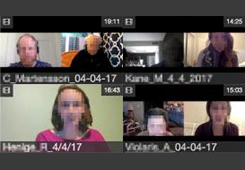Using Video in the Clinical Reasoning Classroom
Juliet Gladden, DVM, DACVECC is an Assistant Professor at the Cummings School of Veterinary Medicine. Last semester, she worked with Educational Technology Services to integrate video assignments into her clinical reasoning course.
You recently explored using video as a means to introduce clinical reasoning to students. Why did you want to try a new approach?
Transitioning veterinary students to the clinical reasoning process requires them taking the leap from the comfort of their textbooks into the realm of clinical patients. The clinical reasoning course is designed to help students bridge the gap between the medical terminology they have only previously read about and the actual patient manifestation of such clinical conditions that they will be faced with on clinics. Video provides a dynamic clinical picture that helps students start to think in terms of a multidimensional and complex “real life” presentation. Video is an ideal media for bringing clinical cases to the classroom, allowing students to fully appreciate how a typical patient is likely to appear and engaging their empathy and compassion for future patients.

VoiceThread is a video and audio collaboration platform which allows instructors and students to post media objects and generate rich online conversations around a given topic. Learn more . . .
For this course, your students used VoiceThread to share examples and make comments. What worked well, and what would you do differently?
Students were asked to upload videos to VoiceThread (VT) of their own pet’s respiratory patterns and identify if they were normal or abnormal. Additionally, they were asked to review videos posted by their peers and clinical case videos I provided and comment on their assessment of the videos. The students felt that VT was relatively easy to navigate using the written instructions we provided them with, and although students were given the option to either upload a personal video or comment on existing videos, the vast majority elected to add their own videos. Having students post videos and comment on the videos prior to class allowed me to identify concepts and clinical presentations that required additional clarification. I was then able to tailor the in-class presentation to include further review of these topics. Student feedback was incredibly positive and I was pleasantly surprised by the students’ request for additional case videos. In the future, I plan to include more clinical case videos so that the students can review a wider variety of patient presentations prior to class, in addition to their personal videos.
How did you assess the impact of this activity?
Since this was my first time relying on video as a sole means of teaching this class, I elected to survey the students both before and after class about their experiences. Students completed a quick on-line pre-class survey, sharing their impressions on using VT and answered a few questions about their readiness for clinics, comfort level with material to be presented and their thoughts on typical “Powerpoint” text-based lectures. Afterwards students were asked to complete an online post-class survey, including their thoughts on the class format and the sole use of video instead of a more traditional classroom lecture format. Students shared positive comments about viewing fellow students’ pets and expressed relatively empathetic comments in regards to the class subject matter during class discussions. The class response was overwhelming positively towards both the nature of the pre-class assignment and the use of videos in lieu of standard lecture format. During class, the students were very engaged with the subjective matter and they felt that it was very clinically applicable to review videos of everyone’s pets as means of understanding respiratory patterns in animals.
What are some lessons learned that you might share with others?
Although it did require some initial investment on my part to learn how to use VT, the rewards of having a dynamic class discussion and the positive student feedback from the use of video as a means of introducing the clinical reasoning process made it well worth my time. I would strongly encourage the use of video in the ongoing instruction of veterinary students. Students were engaged with the material and felt that the videos helped them begin to translate their previously obtained knowledge into more clinically relevant interpretations of patient presentations. In order to rely on video as a means of teaching however, it is important to have a large collection of clinical case videos available to select from and I would recommend working towards building a shared database of clinical videos.
What do you hope to do next?
I intend to continue to integrate additional clinical case videos into the clinical reasoning class and perhaps establish a video database for the students to use as a clinical reference in the future. I look forward to exploring additional software platforms that will allow for the use of video formats in more novel and innovative ways, to further incorporate this technology into my day-to-day classroom activities.
To learn more about VoiceThread and how to use it in your teaching, contact Educational Technology Services at edtech@tufts.edu.





